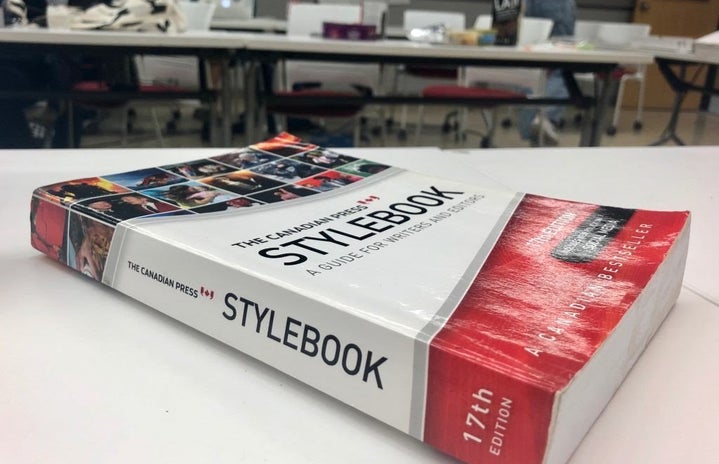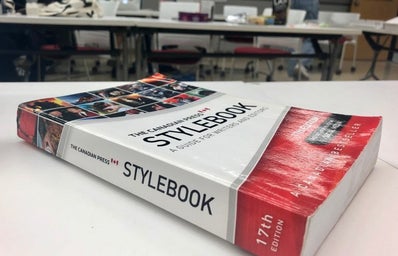Newsroom practices need to be more gender-inclusive, editors say.
“A lot of the editorial guidelines and the systems we’re using for our magazines are not always inclusive,” said Sarah Cuddie, the editorial manager at Womanly Magazine, a health publication for women and non-binary people. “They’re not always current in terms of the language that we use today.”
The National Center for Transgender Equality defines non-binary as people who don’t identify as male or female. Some non-binary people use the pronouns they and them.
The Canadian Press (CP) style guide—a widely used resource for Canadian journalists and journalism students—only accepted the use of “they” and “them” as singular pronouns in early 2018. This came alongside an update that included a section on gender identity for the first time ever.
“The issue of gender identity and expression has evolved rapidly in recent years,” writes the newest CP style guide, “making the best way to report on gender issues a moving target, to say the least.”
CP’s update came one year after the Associated Press(AP), another widely used reference and global wire service, made the decision to include they/them as a gender identity.
Cuddie of Womanly Magazine said that using improper pronouns risks alienating people, and that journalists should be asking their sources what their pronouns are when being interviewed.
“It’s part of responsible journalism,” said Cuddie, “This should be easy.”
Cuddie said that Womanly Magazine consults the Diversity Style Guide, a resource that helps journalists cover complex, multicultural issues with accuracy. When unsure, the editorial team looks to AP, and they decide as a team if they agree or disagree with what’s stated.
Mis-gendering and misrepresentation
The Globe and Mail, a Canadian news outlet, like many newspapers, use CP and AP style guides for reference, but adhere to their own set of rules on particular topics, such as names and titles. The Globe and Mail still uses courtesy titles, such as Mr. and Ms. in front of the last names of their sources.
For gender non-conforming sources, the title ‘Mx.’ (pronounced ‘mix’) comes up in some articles, but there is no actual mention of its usage in their style guide.
Karen Longwell, a visual editor at the Ryerson Review of Journalism, was a reporter at a community newspaper in Cobourg in 2013, when she was told not to use a gender-neutral pronoun for one of her sources.
“The attitudes towards things are a little bit different in small towns,” said Longwell. “It takes a while to catch up.”
Longwell was interviewing Stephanie Stephens, a drag queen performing in Port Hope, who told Longwell they didn’t identify as male or female. When Longwell brought this up to her editor, she was told to use the courtesy title ‘Ms.’
Longwell said small-town papers usually have training for reporters who cover sensitive topics. Gender identity, however, was never covered.
“I remember feeling a little bit awkward in this interview with Stephanie. I didn’t know how to approach that question,” Longwell said.
Diversity in the newsroom
Andrea Houston, a former Ryerson professor that developed the queer media studies journalism course, said that a lack of gender-diversity in newsrooms makes reporting on LGBTQ+ and feminist issues very difficult.
Houston said the reality is that many newsrooms are very white and conservative. “You’ll find it very difficult—unless there’s a queer person in the newsroom—to get those queer stories covered,” said Houston.
Houston said that journalists think of LGBTQ+ issues as to marriage rights, even though it’s only a small fraction of what the community fights for. “Trans people are still killing themselves and being murdered at a record rate,” said Houston. “So there’s way more to do than just fight for marriage. I know this isn’t the issue in Canada anymore but this is still the lens that journalists look through.”
Houston said that journalists adhere to CP almost like a bible, and it sets a tone when style guides aren’t pushing gender-neutral pronouns forward. When Houston was a panellist in 2016, alongside CP editor, Stephen Meurice, they spoke about language representation in the media. Houston said she disagreed with Meurice when he said the CP style guide wasn’t quite ready to accept the use of they/them pronouns.
“A lot of times the institutional changes happen after the rest of society has come to terms with it,” said Houston.



